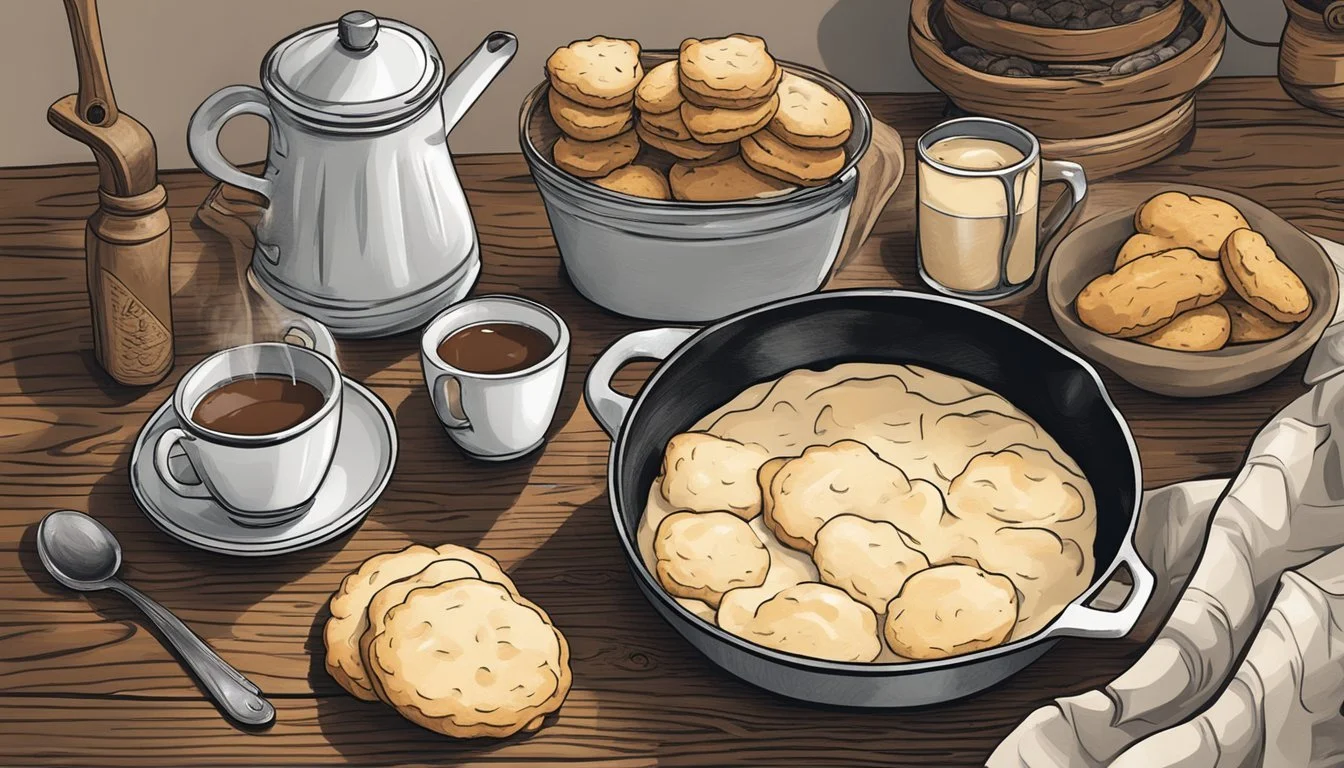How to Create a Texas-Style Biscuits and Gravy Breakfast
A Southern Comfort Guide
Biscuits and gravy stands as a beloved staple in Southern cuisine, a comfort food that has found its way into the hearts and breakfast tables across Texas and beyond. The dish comprises two essential elements: soft, flaky biscuits and rich, creamy gravy, typically punctuated with the hearty flavor of sausage. It embodies a sense of home and warmth, offering a satisfying start to the day that is both nourishing and indulgent.
Creating a Texas-style biscuits and gravy breakfast is about honoring tradition while embracing a bit of culinary flair. The biscuits should be tender and buttery, capable of soaking up the robust gravy without losing their texture. Meanwhile, the gravy, often the star of the show, should be thick and flavorful, with a depth of taste that comes from perfectly browned sausage, a well-crafted roux, and a blend of spices that can range from a hint of black pepper to a spicy kick characteristic of the Lone Star State's love for bold flavors.
In preparing this classic dish, attention to detail is key. From the leavening agents that provide lift to the biscuits, to the patience required to let the gravy thicken just right, there's an art to ensuring that each component comes together harmoniously. Whether enjoyed on a lazy weekend morning or prepared for a special brunch gathering, biscuits and gravy remains a testament to the simple pleasure of a well-cooked breakfast.
The Origins and Popularity of Biscuits and Gravy
Biscuits and gravy emerged as a quintessential Southern comfort food, deeply rooted in American culinary traditions. This hearty breakfast staple dates back to the Revolutionary War era. It began as a humble, cost-effective meal that provided sustenance for the American South's working-class population.
Southern Biscuits: Typically produced with soft dough, Southern biscuits distinguished themselves with their fluffy texture and buttery flavor, a result of chemical leavening advancements.
Sawmill Gravy: The traditional white gravy, also dubbed 'sawmill gravy,' commonly includes milk, flour, and the drippings from pork sausage. Variations often feature bits of bacon (how long does bacon last?), ground beef, or other meats, enhancing both texture and savor.
Evolution: Over time, regional influence has shaped biscuits and gravy, with recipes undergoing refinement and sometimes even receiving a gourmet spin.
Cultural Staple: The dish has not only withstood the test of time but also gained a position of prominence on Southern breakfast menus. Additionally, it has been immortalized through cultural expressions like songs, and there are days dedicated to celebrating this popular dish, emphasizing its significance in Southern heritage.
The popularity of this simple dish reflects an appreciation for its heartiness and deep-seated place in the history of Southern cuisine. The rich flavors and satisfying nature of biscuits and gravy continue to make it a beloved choice among those seeking a taste of Southern hospitality and comfort.
Essential Ingredients for Classic Texas-Style Biscuits
The foundation of any great Texas-style biscuit recipe lies in the careful selection and balance of ingredients. From the flour that establishes the texture to the fats that impart richness, each element plays a pivotal role in achieving the perfect biscuits—flaky, fluffy, and warm straight from the oven.
Choosing Your Flour
For classic Texas-style biscuits, all-purpose flour is the standard choice because of its moderate protein content, which strikes a balance between tenderness and structure. However, for those preferring lighter biscuits or with dietary restrictions, self-rising flour or gluten-free alternatives can be used. Self-rising flour conveniently includes baking powder and salt already mixed in.
The Importance of Fats
The type of fat incorporated into biscuit dough is critical for the end texture. Unsalted butter is a popular choice, delivering a rich flavor and contributing to flakiness when kept cold and cut into the flour properly. Alternatives like shortening, lard, or bacon grease can also be used, each imparting a unique flavor and assisting in achieving that sought-after fluffiness.
Liquids and Leavening Agents
Biscuits require moisture and a leavening agent to ensure they rise appropriately. Buttermilk is a traditional liquid used in Texan recipes, providing a subtle tanginess while reacting with baking soda for leavening. Milk or buttermilk substitutes like milk with lemon juice or vinegar are viable options. Baking powder is also essential to guarantee that your biscuits are well-risen and airy.
Flavor Enhancers
While the base ingredients are essential, the flavor enhancers shouldn't be overlooked. A pinch of sugar can subtly enhance the natural flavors of the biscuit without adding overt sweetness. Salt is crucial for seasoning; options include kosher salt or sea salt, preferred for their clean taste and the ability to control the sodium level. These seasonings should be used sparingly but confidently to balance the flavors within your biscuit dough.
Preparing the Biscuits Dough
Crafting the perfect biscuits dough is a key step in achieving a memorable Texas-style biscuits and gravy breakfast. The dough should be handled with care to maintain a light and flaky texture, essential for the ultimate homemade savory biscuit.
Mixing Techniques
One begins by whisking together the dry ingredients to ensure even distribution of the leavening agents. It is imperative to use cold butter; this is where a pastry cutter or, alternatively, two forks are employed to incorporate the butter into the dry mix. The goal is to create a crumbly texture with pea-sized butter pieces. This approach promotes flakiness within the final product. Sticky dough is to be avoided, so liquids should be incorporated gradually, with gentle stirring, just until the mixture comes together. Overmixing at this stage results in tough biscuits.
Cutting and Shaping Biscuits
Once the dough forms, it needs a light touch. The dough is turned out onto a lightly floured surface and shaped into a rectangle. A minimalist kneading—no more than a few folds—helps to form layers without developing too much gluten. Thickness is a personal preference, but traditionally, about an inch is common for a substantial biscuit. A biscuit cutter ensures uniform rounds, or one can simply use a sharp knife for square biscuits if desired. After cutting, the biscuits are carefully placed on a baking pan, preferably lined with parchment paper or lightly greased. It's important not to twist the cutter when lifting it off the dough, as this can seal the edges, impeding their rise.
Baking to Perfection
When preparing Texas-style biscuits for a hearty breakfast, one's attention to the baking process is paramount. The oven, consistent in heat distribution, is the preferred tool for achieving golden, flaky biscuits. Connoisseurs often recommend preheating the oven to a high temperature—around 425°F (220°C) to ensure the dough rises rapidly, creating the desired texture.
Ingredients for Biscuits:
Baking powder
Cold butter
Milk or buttermilk
Procedure:
Prepare the Dough:
In a mixing bowl, blend the dry ingredients thoroughly.
Cut the cold butter into small pieces, and then incorporate it into the flour mixture until it resembles coarse crumbs.
Shape the Biscuits:
After combining with milk or buttermilk, turn the dough onto a floured surface.
Gently knead before pressing it out and cutting biscuit shapes.
Bake the Biscuits:
Place the biscuits on a lined baking sheet, ensuring they are spaced evenly.
Bake in the preheated oven for 12-15 minutes or until they exhibit a golden-brown hue.
The use of a cast iron skillet is not typical for baking biscuits but is essential for preparing authentic Texas-style gravy to accompany them. The skillet's heat retention properties make it ideal for cooking the sausage evenly, and then for integrating the roux with the perfect consistency to complement the freshly baked biscuits.
Creating Rich Sausage Gravy
A successful Texas-style sausage gravy combines well-selected meat with a flavorful roux base, enhanced by carefully chosen seasonings and smoothed to perfection with the right choice of liquid. Attention to detail in each step ensures a rich, velvety gravy that's signature to any Southern breakfast.
Selecting the Right Meat
The choice of meat for sausage gravy is crucial for authentic taste. Breakfast sausage, typically a pork sausage, is the preferred option for its balance of fat and lean meat. Some opt for turkey sausage for a leaner version. It's essential to use fresh, high-quality sausage to form the foundation of gravy with a deep, savory flavor.
Building the Foundation With Roux
The traditional roux acts as a thickening agent and is made by cooking flour with butter or sausage drippings. The flour should be cooked until it's a light golden brown; this ensures the eradication of the raw flour taste and provides the gravy with a nutty undertone.
Seasonings and Spices
A tasteful amount of seasonings and spices are critical to a standout sausage gravy. A staple in sausage gravy is black pepper, providing a sharp bite, and sage, lending a hint of earthiness. For a Texas-style kick, a pinch of red pepper flakes may be added. Quality matters—as freshly ground spices often yield the best flavors.
Finishing With Liquids
To finalize the gravy, gradually whisk in a liquid such as whole milk, cream, or a combination of both to achieve a velvety texture. Skim milk can be used, but will result in a less creamy consistency. Continue to cook the mixture on a low heat, stirring continuously until the gravy reaches the desired thickness and smoothness.
Assembling Biscuits and Gravy
To assemble a classic Texas-style biscuits and gravy breakfast, one must first prepare the essential components—homemade biscuits and savory gravy.
Biscuits: The foundation of this dish is either buttermilk or southern biscuits, known for their flaky texture and rich flavor. To start:
Bake: Prepare the biscuit dough and cut into rounds.
Heat: Preheat the oven to 425 degrees Fahrenheit.
Cook: Bake the biscuits for about 10 to 15 minutes until golden brown.
Gravy: The gravy is a robust companion to the light biscuits. It should be creamy with a thickness that coats a spoon but still pours easily.
Cook: In a skillet, cook seasoned sausage over medium heat until browned.
Thicken: Sprinkle flour over the sausage, stirring until absorbed.
Mix: Gradually add milk, stirring continuously to prevent lumps.
Simmer: Cook the mixture until it reaches the desired thickness, usually in about 5 minutes.
Assembly:
Split: Once the biscuits are baked, split them open on a plate.
Pour: Ladle the hot, thickened gravy over the warm biscuits.
One should garnish the dish as desired, perhaps with a sprinkle of freshly chopped parsley or a pinch of black pepper to add both color and a gentle kick. The key to a great assembly is ensuring the biscuits are warm and the gravy is thickened to perfection, enveloping the biscuits in a hearty embrace.
Accompaniments and Variations
When crafting a Texas-style biscuits and gravy breakfast, expanding the menu with additional items and customizations enhances the dining experience. Understanding how to balance the heartiness of the main dish while introducing complementary flavors ensures a fulfilling brunch.
Additional Breakfast Items
A well-rounded breakfast often includes eggs, which can be served scrambled or fried, adding a protein boost to the meal. They can enjoy hash browns or breakfast hash with an assortment of onions, peppers, and leftover meat for a savory delight. For a Southern twist, one might serve cheese grits alongside for a creamy and comforting addition. Breakfast tacos, incorporating eggs, cheese, and if preferred, a spoonful of sausage gravy, make for a flavorful handheld option.
Sides and Toppings
To further complement biscuits and gravy:
Bacon or turkey sausage: For those desiring extra protein.
Grits: Plain or cheese-infused for a Southern classic pairing.
Hot sauce: A splash for those who prefer an added kick of spice.
Maple syrup: A drizzle on biscuits for a sweet and savory combination.
Alternative Gravy Flavors
One can adjust gravy flavors by incorporating various ingredients:
Mushrooms: For a vegetarian-friendly option.
Onions: Sautéed until caramelized can add a depth of flavor.
Meat: Substitute traditional pork sausage with turkey or beef for different tastes.
Dietary Adjustments
For guests with dietary restrictions, consider:
Gluten-free: Utilize gluten-free flour for a safe roux base in the gravy.
Make-ahead: Prepare elements of the dish in advance. Biscuits can be made and then frozen, and gravy flavors often deepen when left overnight.
Substitutions: Offer nondairy milk and butter alternatives for those avoiding dairy.
By incorporating these elements, diners can indulge in a robust Texas-style biscuits and gravy breakfast, tailored to a range of tastes and dietary needs. Whether adding sides for a larger spread or tweaking gravy flavors, these accompaniments and variations cater to both tradition and individual preferences.
Practical Tips for Serving and Storage
Serving and storing Texas-style biscuits and gravy can greatly affect their quality. This section provides detailed advice on presenting this hearty breakfast to guests and preserving its taste and texture for later enjoyment.
Serving Suggestions
When serving biscuits and gravy, one must consider the desired thickness of the gravy. A thicker gravy typically provides a richer flavor and clings well to the biscuits. It can be adjusted to personal preference with a careful watch over the saucepan as one cooks, stirring diligently to ensure even thickening. For an extra kick, a splash of hot sauce can be offered on the side, alongside maple syrup for those who enjoy a hint of sweetness contrasting the savory gravy.
Storing and Reheating
Leftovers should be stored in separate airtight containers, with biscuits and gravy kept apart to maintain texture. The gravy can be refrigerated for up to three days. When reheating, the gravy should be transferred to a saucepan and warmed slowly over medium heat, stirring occasionally. If the gravy has thickened too much during storage, adding a small amount of milk can restore its consistency. Biscuits are best reheated in an oven at 350°F for a few minutes until warm.
Making Biscuits Ahead of Time
For those looking to make ahead, biscuits can be prepared and then frozen until ready to bake. Simply place unbaked biscuits on a baking sheet, freeze until solid, and transfer to a freezer bag. They can be baked straight from the freezer, adding a few extra minutes to the original cooking time. Always remember to preheat the oven for optimal results. This method ensures fresh, hot biscuits with minimal preparation time in the morning.
Additional Considerations and Tips
When creating a Texas-style biscuits and gravy breakfast, one should focus not only on quality ingredients but also on appropriate cookware, thoughtful herb and seasoning choices, and understanding the impact of latent heat in cooking.
Cookware Choices
Selecting the right cookware can greatly affect the texture and flavor of the biscuits and gravy. A cast iron skillet is traditionally used for making gravy because of its even heat distribution and its ability to add a slight hint of iron to the dish, which can enhance the flavors. For biscuits, a baking pan with a light color is ideal, as it reflects heat, allowing the biscuits to bake evenly without the bottoms becoming too brown.
Herbs and Seasoning Varieties
Herbs and spices are crucial for giving the gravy its signature savory flavor. Sage and dried thyme are common in Texas-style recipes, imparting an earthy and subtle woodiness to the dish. They should not overpower the dish but should complement the rich sausage flavor. Experimenting with additional herbs like rosemary can also add depth, but one must use such potent herbs with restraint to maintain the classic taste profile.
Latent Heat in Cooking
Understanding latent heat is important when making gravy. After removing the skillet from the heat, it retains heat due to latent energy, which can continue cooking the gravy. This retained heat can be used to one’s advantage to gently finish the gravy without the risk of scorching. It is key to remove the skillet from the heat a few minutes before the gravy reaches the desired consistency, as it will thicken slightly from the residual heat.
Conclusion: Embracing the Art of Biscuits and Gravy
Creating a Texas-style biscuits and gravy breakfast epitomizes Southern comfort food at its finest. This dish's heartiness and depth of flavor make it a treasured weekend staple.
Southern biscuits, tender and flaky, provide the ideal base for ladling generous servings of rich gravy. A Southern sausage gravy, thickened with flour, clings to the biscuits, imparting a spicy and meaty complement to the baked dough.
For authentic homemade biscuits and gravy, start with high-quality ingredients, such as those from HEB, a store synonymous with Texan fare. To achieve the best results in gravy consistency, a roux is essential—a simple combination of fat and flour cooked together before adding the liquid.
To prepare this classic dish:
Begin by baking the biscuits, aiming for a golden-brown crust and a soft, buttery interior.
Simultaneously, brown the sausage, ensuring it's crumbled to preference.
Sprinkle flour over the cooked sausage, making a base for the roux.
Gradually stir in milk or a milk substitute until the mixture reaches a creamy consistency.
Tips for Supreme Gravy:
Season well, with black pepper and a pinch of cayenne for an authentic Southern kick.
Constant stirring eliminates lumps and results in a smooth, creamy gravy.
One learns that this breakfast is more than a meal; it's a revered tradition. By embracing these techniques, anyone can master how to make biscuits and gravy, capturing the essence of Southern hospitality on a plate.





